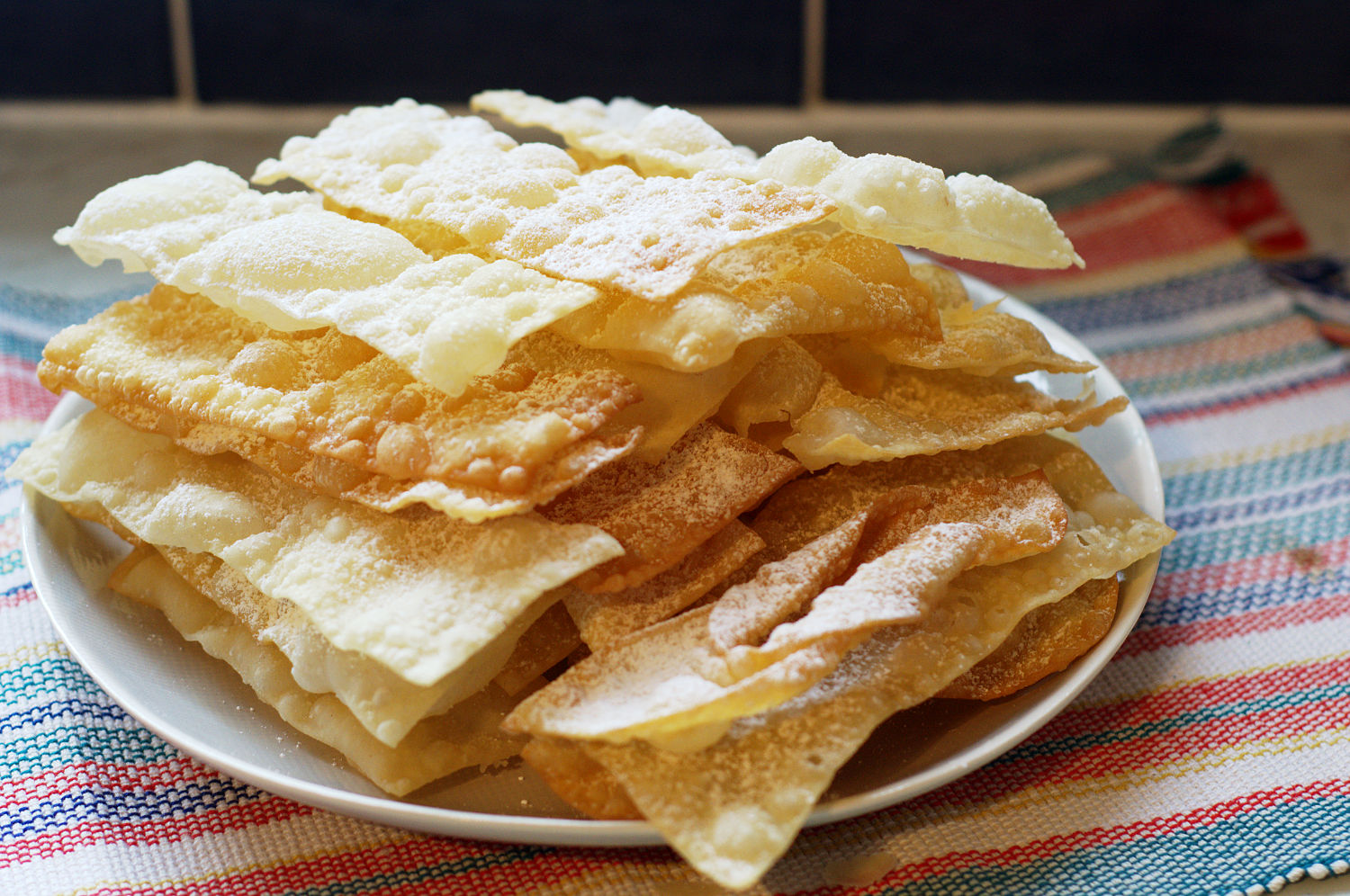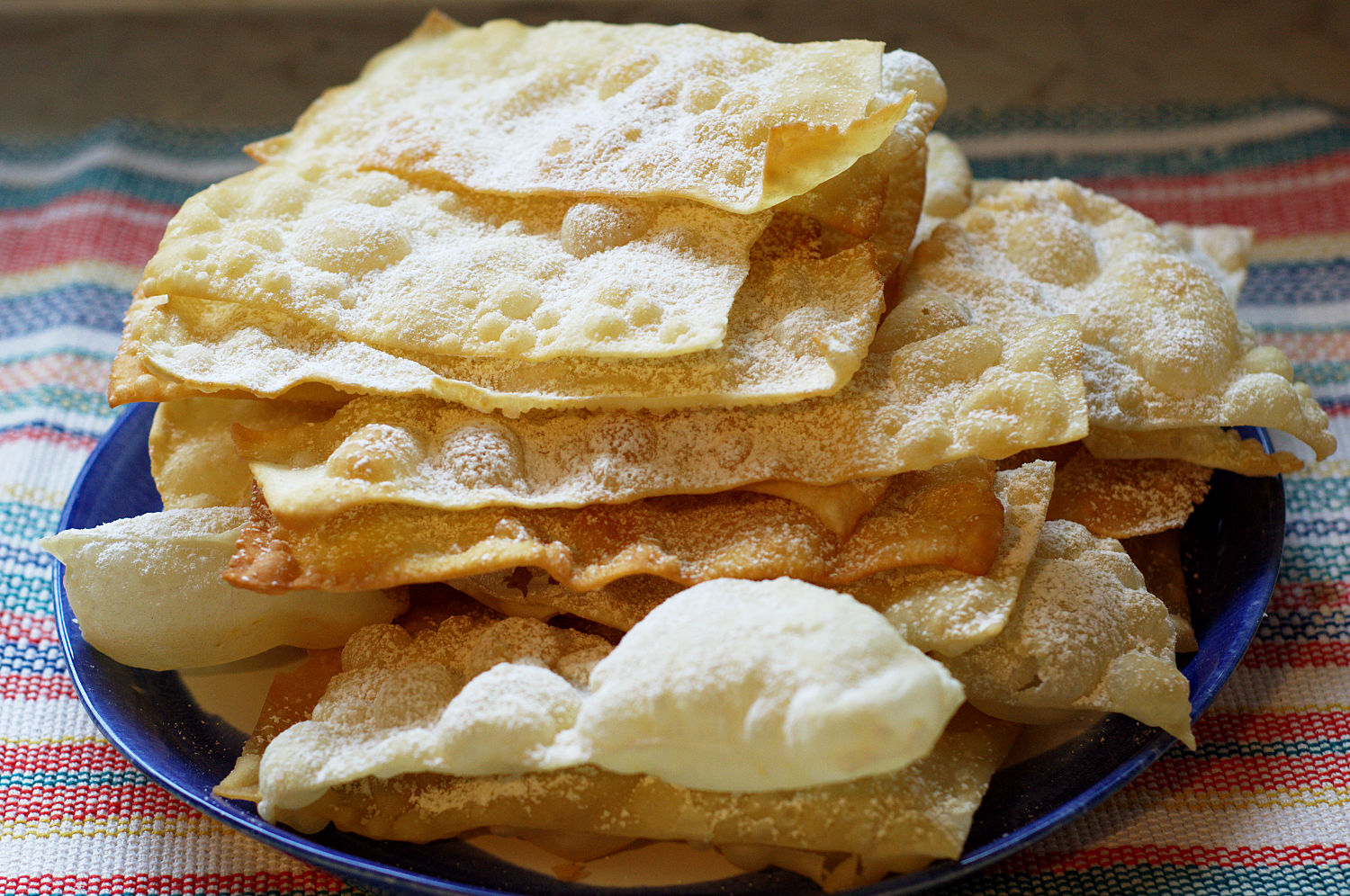Like pasta, cenci go by many names all over Italy and every region has its own take on this delicious carnival treat. It seems no one can resist their crisp, sugar-coated charm.
In Italy Carnival is a time to celebrate with one final indulgence before Lent, this tends to mean plenty of fried sweets. Made by frying delicate sheets of sweet dough until they puff up into light, crispy wafers and covered in powdered sugar, cenci are my personal favourite. Even though fasting is not that popular anymore, Carnival treats inevitably start appearing in bakeries and patisseries every February.
The Swiss also have their own version of cenci, which they call Fasnachtkuechli (try saying that with a mouthful of fried pastry). I can picture my mother sat at the kitchen table with a pile of Fasnachtkuechli in front of her, stretching them across her lap until they were thin enough. She would always say that she would stop once they were thin enough to read the recipe through. Fasnachtkuechli are round and thin and made with a simple dough of white flour, egg, a little sugar, a little milk and some melted butter.
Here in Tuscany we call them cenci, the Tuscan word for cloths, owing to their irregular shape. While researching this recipe I turned to Paolo Petroni and his “Il Libro della Vera Cucina Fiorentina” for a traditional take. His recipe calls for flour, egg and sugar as in the Swiss version, but the flavour is made more complex with the addition of vinsanto (a local fortified wine), and some orange or lemon zest. Other recipes from around Italy call for grappa instead of vinsanto.
I’m going to present both a Swiss-inspired and Tuscan version here, choose the one that tickles your fancy the most or try both and tell us which you preferred! Both can be made with either plain white flour or Senatore Cappelli flour, the plain flour tends to make the cenci puff better while the Senatore Cappelli adds a bit more bite and helps the cenci keep for a few days more. I’ve also substituted the butter in the recipes for olive oil which makes them lighter and crispier.
When making cenci, it’s important to keep an eye on the thickness of the dough. You need to pull the dough as thin as possible. My mum used to use a rolling pin before stretching the dough on her lap. In the spirit of indulgence I decided to make my life a bit easier and use a pasta machine to stretch out the dough. If the dough starts to tear don’t worry, just work it back together and put it back through, stopping one level earlier.

SENATORE CAPPELLI CENCI
INGREDIENTS:
150g Senatore Cappelli durum wheat flour (or plain white flour)
1 egg
2tbsp milk
10g sugar
Plenty of oil for frying
Powder sugar to coat
METHOD
- Mix the flour and sugar with a pinch of salt in a wide bowl. On a separate bowl beat the egg together with the milk and olive oil. Pour the egg mixture over the flour and mix well, then knead until you get a firm and elastic dough, similar to pasta dough. Wrap the dough in cling film and leave to rest in the fridge for at least 30 minutes.
- Split the dough in two parts and start pulling the dough with the pasta machine working your way progressively through the settings, from thickest to thinnest. Make sure your dough has a consistent thin coat of flour throughout the process so that it won’t stick to the machine. If the dough was to pull apart, don’t worry, just work the dough back together in a ball, then flatten it and start pulling it thinner and thinner again, this time stopping on the setting before the thinnest.
- Once you’ve pulled the dough, cut it in the shape you prefer (rectangles, triangles or whatever you like). If you didn’t manage to pull the dough to the thinnest setting or if you used the rolling pin, make sure to pull each cencio by the edges, so to make it thinner.
- Pour a 3cm thick layer of oil in a large frying pan and heat it up to 160ºC if you’re using a thermometer, or until a small piece of dough starts puffing up immediately when put in the oil, but doesn’t instantly brown. When the oil is warm enough, gently place 2 or three cenci at the time in the frying pan. The cenci will float on the surface and you’ll notice that the side in the oil will start puffing immediately. Using some heat resisting tongues, flip the cenci on the other side after about 20 sec. This will allow the cenci to puff nicely on both sides before they crisp up. Keep on cooking the cenci flipping them over quite often until they start to golden, then place them on a tray covered in kitchen paper. Fry the cenci in batches until you run out of dough.
- When the cenci are cool and dry, coat them in powder sugar and serve.

TUSCAN CENCI
INGREDIENTS:
150g plain white flour
10g sugar
10g extra virgin olive oil
1 egg
2 tbsp of sweet vinsanto
the zest of ½ a lemon
salt
plenty of oil for frying
Powder sugar
METHOD:
- Mix the flour and sugar with a pinch of salt in a wide bowl. On a separate bowl beat the egg together with the melted butter, the vinsanto, and the grated zest. Pour the egg mixture over the flour and mix well, then knead until you get a firm and elastic dough, similar to pasta dough. Wrap the dough in cling film and leave to rest in the fridge for at least 30 minutes.
- Split the dough in two parts and start pulling the dough with the pasta machine working your way progressively through the settings, from thickest to thinnest. Make sure your dough has a consistent thin coat of flour throughout the process so that it won’t stick to the machine. If the dough was to pull apart, don’t worry, just work the dough back together in a ball, then flatten it and start pulling it thinner and thinner again, this time stopping on the setting before the thinnest.
- Once you’ve pulled the dough, cut it in parcels of the shape you prefer (rectangles, triangles or whatever you like). If you didn’t manage to pull the dough to the thinnest setting or if you used the rolling pin, make sure to pull each cencio by the edges, so to make it thinner.
- Pour a 3cm thick layer of oil in a large frying pan and heat it up to 160ºC if you’re using a thermometer, or until a small piece of dough starts puffing up immediately when put in the oil, but doesn’t instantly brown. When the oil is warm enough, gently place two or three cenci at the time in the frying pan. The cenci will float on the surface and you’ll notice that the side in the oil will start puffing immediately. Using some heat-resisting tongues, flip the cenci on the other side after about 20 sec. This will allow the cenci to puff nicely on both sides before they crisp up. Keep on cooking the cenci flipping them over quite often until they start to golden, then place them on a tray covered in kitchen paper. Fry the cenci in batches until you run out of dough.
- When the cenci are cool and dry, coat them in powder sugar and serve.